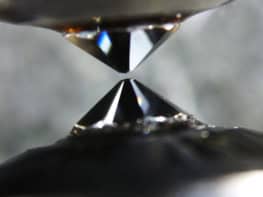The strong electric field from an intense laser pulse can cause electrons to "tunnel" away from an atom in just one billion-billionth of a second. Now physicists in Germany are the first to observe this well-known quantum-mechanical process as it proceeds in real time. The breakthrough paves the way for a new technique that can probe short-lived states of atoms or molecules, giving the first direct insight into the dynamics of electron tunnelling (Nature 446 627).

A laser pulse consists of a small number of electric-field oscillations that can pull the outer electrons of atoms away from their binding nuclei. At the peaks of these oscillations, the pull can be so great that the outer electrons are given a chance to escape (or tunnel) from the atom, even though they don’t have enough energy to overcome the attractive pull of the nucleus. But this process occurs so quickly that current instruments can only see the final ionized atom, and not any intermediate states.
Ferenc Krausz and colleagues from the Max-Planck Institut für Quantenoptik have now found a way around instrument limitations by probing atoms with two pulses of different-wavelength light that are carefully-timed to take snapshots of the tunnelling process.
The technique involves probing atoms that have very tightly bound electrons – in this case those of neon – which do not readily ionize with a laser pulse alone. The atoms must first be prepared by an exciting pulse, which sends some of the electrons to outer regions of the atom where tunnelling can be induced by an ionizing pulse.
This two-stage process is where the advantage lies: if the exciting pulse has a much shorter wavelength than the ionizing laser pulse, it can be switched on at many points in the ionizing pulse’s cycle, and only at these points will electrons be in a position to tunnel. Then, by noting when in the ionizing laser’s cycle the electrons tunnel, a picture of how the electrons leave the atom can gradually be reconstructed.
In practice the two pulses must be synchronized to within several billion-billionths of a second to achieve any sort of accuracy. To get over this hurdle, Krausz and his team used the same infrared laser to make both pulses. First, they shone the laser though a gas jet to produce a pulse of extreme (very short wavelength) ultraviolet light. This pulse then travelled to the sample of neon atoms with the original laser pulse delayed behind. Finally, using mirrors to carefully alter the delay, the physicists could chart the tunnelling of the electrons with a resolution of less than one femtosecond (10-15 s).
According to 40-year-old quantum theory, the probability of an electron tunnelling through the potential barrier should increase stepwise with every successive peak of the ionizing pulse. Now Krausz and his team are the first to be able to confirm this is exactly the case (see figure: “Tunnelling”).
The light-induced tunnelling technique may now be used to provide further observations of electron movement, giving scientists unprecedented insights in areas such as microelectronics and biological imaging. “There may be issues with transient [short-lived] states that we’ve never been able to capture,” Jonathan Marangos, an expert in sub-femtosecond technology, told Physics Web. “This technique will enable us to do that.”


